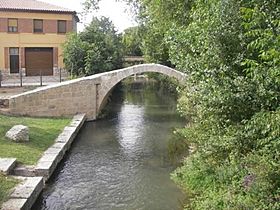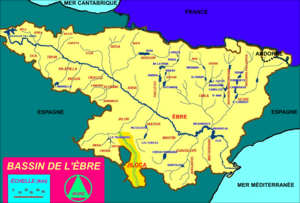Jiloca (river) facts for kids
Quick facts for kids Jiloca |
|
|---|---|

|
|

Map of the Jiloca in the Ebro basin
|
|
| Other name(s) | Giloca |
| Country | Spain |
| Region | Aragón |
| District | Teruel, Zaragoza |
| City | Pancrudo |
| Physical characteristics | |
| Main source | Ojos de Monreal Monreal del Campo, Teruel, Aragón 950 m (3,120 ft) 40°45′37″N 1°21′07″W / 40.76041°N 1.351933°W |
| 2nd source | Fuente de Cella Cella, Teruel, Aragón 1,036 m (3,399 ft) 40°27′17″N 1°17′13″W / 40.454602°N 1.286831°W |
| River mouth | Calatayud, Zaragoza, Aragón 530 m (1,740 ft) 41°20′27″N 1°39′27″W / 41.340962°N 1.657459°W |
| Length | 126 km (78 mi) |
| Basin features | |
| Progression | Jalón→ Ebro→ Mediterranean Sea |
| Basin size | 2,957 km2 (1,142 sq mi) |
| River system | Ebro |
The Jiloca (pronounced hee-LOH-kah) is a river in Aragón, Spain. It flows into the Jalón River, and its waters eventually join the mighty Ebro River. The Jiloca travels through the Spanish provinces of Teruel and Zaragoza.
This river is about 126 kilometres (78 mi) long. On average, about 2.1 cubic metres per second (74 cu ft/s) of water flows through it, but this amount changes with the seasons. The Jiloca generally flows towards the northeast, starting from its source near Monreal del Campo. For a long time, the Jiloca valley was an important path connecting the central plateau of Spain to the Mediterranean coast. You can still see old Roman bridges in many towns along the river.
Contents
Where Does the Jiloca River Start and Flow?
People used to think the Jiloca started at an artesian well called the Fuente de Cella, located in the Teruel province. An artesian well is a special well where water flows up naturally from underground. This well has a cool, round wall built by an Italian engineer named Domingo Ferrari.
However, experts now believe that the part of the river between Cella and Monreal del Campo is actually an old canal. This canal was dug in the 1700s to drain a lake called Laguna Cañizar. Today, it's generally accepted that the Jiloca River truly begins at the "Ojos" (which means "Eyes") of Monreal. These "Ojos" are a group of small ponds connected by channels, about 2 kilometres (1.2 mi) from Monreal.
From Monreal, the river flows north. Near Luco de Jiloca (which is part of Calamocha), the Jiloca meets its only major branch, called the Pancrudo River. The Pancrudo starts about 46 kilometres (29 mi) away in the Sierra de la Costera mountains. After this point, there's an irrigation channel that helps water a small valley near Daroca.
The Jiloca continues flowing northeast past several towns. These include Manchones, Morero, Montón, Morata de Jiloca, Maruenda, and Paracuellos de Jiloca. Finally, it joins the Jalón River between Carramolina and Calatayud. Many towns along its path are even named after the river, like Morata de Jiloca and Fuentes de Jiloca.
How Much Water Flows in the Jiloca?
The Jiloca River has an average flow rate of about 2.1 cubic metres per second (74 cu ft/s). This means that much water passes a certain point each second. However, the amount of water changes throughout the year. This is because the central plateau of Spain has long dry seasons. The river gets more water during the wet seasons in spring and autumn.
The amount of rain in the Jiloca river's basin (the area of land that drains into the river) varies. It can range from about 400 millimetres (16 in) to 950 millimetres (37 in) per year. Most of the rain falls in May and June. The entire area that collects water for the Jiloca River is about 2,957 square kilometres (1,142 sq mi).
Wildlife and Nature Along the Jiloca
The Ojos de Monreal, where the Jiloca begins, are natural springs that form pools connected by small channels. This area is full of amazing wildlife! You can find many kinds of birds here, like waterfowl (ducks and geese), grebes, wrens, kingfishers, owls, orioles, and woodpeckers. Sometimes, wild birds from the Laguna de Gallocanta lake, which is about 23 kilometres (14 mi) away, come to visit.
The area around the Ojos de Monreal has many poplar, willow, and walnut trees. These trees provide great shelter for the animals. The water in this part of the river is considered very clean and healthy.
Further downstream, in the valley between Manchones and Morero, you can spot other birds like goshawks, eagles, robins, finches, hoopoes, and kestrels. In the Sierra Santa Cruz mountains, which are next to the river, you might even find deer and bobcats. Smaller animals like hedgehogs and shrews live near the riverbanks. The trees in this area include poplars, elm, and ash.
In the past, there were some concerns about cleaning work done by the regional government. Some environmental groups said that these projects were harming the plants along the riverbanks and affecting the fish and other wildlife. In 2009, a study was started to look into soil erosion in the Jiloca basin. This study aimed to find better ways to use the land in the future, protecting the river's environment.
History of the Jiloca Valley
For a long time, the Jiloca River was used to power many watermills. These mills used the river's flow to grind grain or do other work. Today, only the ruins of these old mills remain, showing us a glimpse of the past.
As mentioned, the Jiloca valley has always been an important travel route. It connected the central parts of Spain to the Ebro River and the Mediterranean coast, known as the Levante. Because of its importance, you can still see many ancient Roman bridges in the small towns along the valley. These bridges are a reminder of the valley's long history.
The Pancrudo Tributary
The Jiloca River has one main tributary, which is a smaller river or stream that flows into a larger one. This tributary is called the Pancrudo. It starts about 3 kilometres (1.9 mi) above the town of Pancrudo in Teruel province.
The Pancrudo generally flows northeast, passing towns like Torre los Negros, Navarette del Rio, and Lechago. After traveling about 46 kilometres (29 mi), it joins the Jiloca River at Luco de Jiloca.
See also
 In Spanish: Río Jiloca para niños
In Spanish: Río Jiloca para niños
- List of rivers of Spain
- Ribera del Jiloca
- Jiloca Comarca


